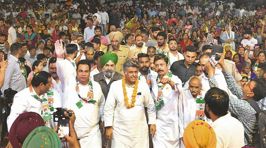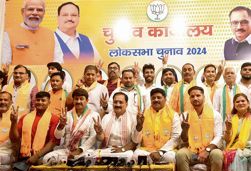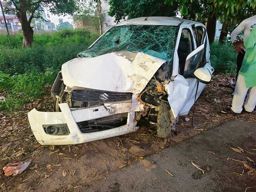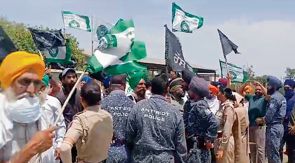
Aruti Nayar
For Sobti, language had to be precise; it is what one has acquired through life patterns in relation to social reality. The speech itself was a sensibility
When eminent Hindi novelist Krishna Sobti passed away recently, it brought back memories of an interview long back. As an avid fan of her writing, I went to meet her when she was a Fellow at IIAS, Shimla. I landed up at her lodge a wee bit sheepish, since I had been soaked in the torrential October rain.
I was welcomed warmly, whisked away inside and handed a towel, instructed to remove my shoes and socks and dry my hair. Over hot tea and pinnis, she fussed over me like a true-blue Punjabi. The veneer of formality dropped, and instant rapport was established.
Mesmerised, I listened as she traced her journey from Gujarat in Pakistan where she was born to her education in Lahore, Shimla and Delhi. She grew up to love the elemental vigour of Punjabi life in all its forms and hues. The family had lost all its holdings in the Partition and circumstances nudged her to work as the governess of Maharaja Tej Singh in Sirohi, Mt Abu, Rajasthan.
It was during her childhood that seeds of her writerly self were laid. She and her siblings (two sisters and a brother) could buy as many books and stationery, but not other things. She talked of how her personality was shaped by her parents. The quiet reflective and imaginative make-up came from her father, and the sturdy rock-like strength and resilience from her mother. After the lights were switched off at 9.30 pm, Sobti’s father would read out stories to the children and in the silences of the night, she would let her imagination run riot and become aware of the nuances of the language.
This unleashing of creative impulses at night continued well into her adulthood. She wrote rigorously and with fidelity to truth from 10.30 pm to 4.30 am. Since it was so exacting, writing for her could never be a hobby or a part-time activity but only a full-time vocation that she devoted herself to 1980 onwards, as she quit her job in the Delhi Administration’s Adult Literacy Department.
She felt that a writer’s deepest concern and honesty was to reach the truth, and not look at things but into them. For her, language had to be precise; it is what one has acquired through life patterns in relation to social reality. The speech itself was a sensibility. What stayed with her was also the way she was taught how to build up an argument, reason and then take a decision. Once it was done, there was no passing the buck but accepting the responsibility of her decisions. That is why, “there were no sob stories.”
Once her bed-ridden mother had told Krishna, “Throughout my life, I looked after all of you with clock-work precision. I never did all the things that I wanted to. You must do all the things your heart tells you to.” This had shocked her into a sudden awareness of the importance of ‘me time’ in a woman’s life. Sobti never wanted to be ‘a clock’ that never ticks for itself. All her creativity and literary output was an offshoot of this very conviction.
Sobti believed that the language in the villages and small towns was still vibrant. In the urban areas people had become soft. It's the cadence of the spoken word that always held sway in her fictional landscape
For Sobti, a writer was a person, not just a man or a woman. No wonder, she used the pseudonym ‘Hashmat’, who she called her spiritual double. One can sum up Krishna Sobti in the words of Victor Hugo who once said: “That a writer is a world trapped within a person”. She truly was one such person.
Chronicler of her times
Sobti’s first story Lama (1944) was followed by Nafisa in the same year. Both were published in the leading literary journal Vichar, edited by Bhagwaticharan Verma.
Zindaginama was a reworked version of her first novel Channa, given for publication in 1952 and later withdrawn. A novel of epic proportions, it has been perceived as the most comprehensive, sensitive and sympathetic treatment of the peasant since Prem Chand. Mitro Marjani (1967) was a landmark novel. Sobti had modelled the character on an extremely provocative madadgar woman from Rajasthan.
Sikka Badal Gaya dealt with the aftermath of the Partition. Surajmukhi Andhere Ke, was published in 1972 and dealt with a woman's struggle to come to terms with childhood abuse. Aai Ladki, a more recent novel, narrates the relationship between an old woman on her deathbed and her daughter, who acts as her companion and nurse.



























